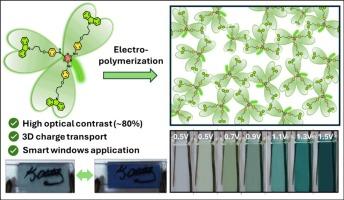Trefoil-shaped monomer with carbazole-functionalized triazine core for high-performance multi-electrochromic polymer films and devices
IF 6.3
2区 化学
Q1 POLYMER SCIENCE
引用次数: 0
Abstract
The structural architecture of a material plays an important role in tailoring its electrical, mechanical, and optical properties. One of the most effective, simple, and rational approaches used in molecular design is the synthesis of monomers having three carbazole units attached to the s-triazine nucleus. Herein, we mainly highlight the design and synthesis of a novel three-armed trefoil-shaped monomer (N2,N4,N6-tris(4-(4-(9H-carbazol-9-yl)butoxy)phenyl)-1,3,5-triazine-2,4,6-triamine). The 3-TCN encoded trefoil-shaped monomer has been electropolymerized by using the cyclic voltammetry (CV) method in a 0.1 M TBAPF6/DCM electrolyte solution. The surface morphology results showed a microporous structure, which can be attributed to the high electrical and optical performances of the polymer film. The cross-linked polymer with three-dimensional charge transport has been found to have improved optical and electrical properties with excellent optical contrast, fast switching time, and long-term stability. The obtained P3-TCN polymer film has exhibited multi-electrochromic properties with color diversity of transparent, yellow, green, and dark green under different applied potentials. High-performance P3-TCN polymer film could be used as an anodic coloring component in the construction of smart windows. Based on this, the solid-state electrochromic device (ECD) consisting of P3-TCN and PEDOT has been fabricated, and its opto-electrical properties have been characterized.

具有卡唑功能化三嗪核的三叶草形单体,用于高性能多电致变色聚合物薄膜和器件
材料的结构结构在决定其电学、机械和光学性能方面起着重要作用。在分子设计中使用的最有效、最简单、最合理的方法之一是合成具有三个咔唑单元连接到s-三嗪核的单体。本文主要设计和合成了一种新型三叶形三臂单体(N2,N4, n6 -三(4-(4-(9h -咔唑-9-基)丁氧基)苯基)-1,3,5-三嗪-2,4,6-三胺)。用循环伏安法(CV)在0.1 M TBAPF6/DCM电解质溶液中对3-TCN编码三叶草状单体进行了电聚合。表面形貌结果显示微孔结构,这可归因于聚合物薄膜的高电学和光学性能。具有三维电荷输运的交联聚合物具有优异的光学对比度、快速的开关时间和长期稳定性,从而改善了光学和电学性能。所制得的P3-TCN聚合物薄膜在不同的应用电位下表现出透明、黄色、绿色和深绿色的多种电致变色特性。高性能的P3-TCN聚合物薄膜可作为阳极着色材料用于智能窗户的构建。在此基础上,制备了由P3-TCN和PEDOT组成的固态电致变色器件(ECD),并对其光电性能进行了表征。
本文章由计算机程序翻译,如有差异,请以英文原文为准。
求助全文
约1分钟内获得全文
求助全文
来源期刊

European Polymer Journal
化学-高分子科学
CiteScore
9.90
自引率
10.00%
发文量
691
审稿时长
23 days
期刊介绍:
European Polymer Journal is dedicated to publishing work on fundamental and applied polymer chemistry and macromolecular materials. The journal covers all aspects of polymer synthesis, including polymerization mechanisms and chemical functional transformations, with a focus on novel polymers and the relationships between molecular structure and polymer properties. In addition, we welcome submissions on bio-based or renewable polymers, stimuli-responsive systems and polymer bio-hybrids. European Polymer Journal also publishes research on the biomedical application of polymers, including drug delivery and regenerative medicine. The main scope is covered but not limited to the following core research areas:
Polymer synthesis and functionalization
• Novel synthetic routes for polymerization, functional modification, controlled/living polymerization and precision polymers.
Stimuli-responsive polymers
• Including shape memory and self-healing polymers.
Supramolecular polymers and self-assembly
• Molecular recognition and higher order polymer structures.
Renewable and sustainable polymers
• Bio-based, biodegradable and anti-microbial polymers and polymeric bio-nanocomposites.
Polymers at interfaces and surfaces
• Chemistry and engineering of surfaces with biological relevance, including patterning, antifouling polymers and polymers for membrane applications.
Biomedical applications and nanomedicine
• Polymers for regenerative medicine, drug delivery molecular release and gene therapy
The scope of European Polymer Journal no longer includes Polymer Physics.
 求助内容:
求助内容: 应助结果提醒方式:
应助结果提醒方式:


